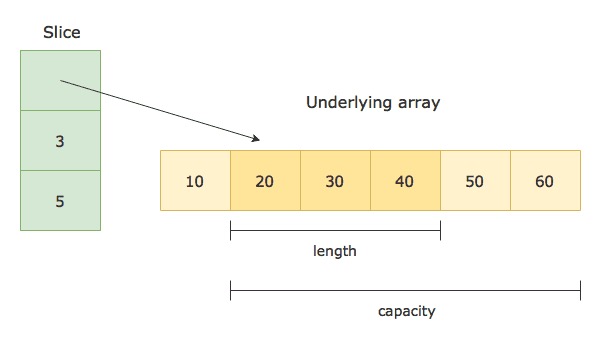切片的容量是怎样增长的 | Go 程序员面试笔试宝典
basic operator
create:
1
2
3
4
|
s := []int{1,2,3}
s1 := make([]int, 2, 2)
fmt.Println(len(s1),cap(s1))
|
basic operate:
1
2
3
4
5
6
7
8
9
10
11
12
13
14
15
16
17
18
|
// append
s = append(s,4)
// cut
s = s[0:1]
//range
for index,value := range s {
....
}
copy(slice1, slice2)
// max slice lenght=cap
s := make([]int, 3,4)
s = s[:] // [0,0,0]
s = s[:cap(s)] // [0,0,0,0]
|
inert at some Index:
1
2
3
4
5
6
7
8
9
10
11
12
13
14
15
16
|
var position = 2;
var element = 100;
var a = []int{1,3,4}
// func1
var inserts []int
inserts = append(inserts, a[:position])
inserts = append(inserts,element)
inserts = append(inserts,a[position:])
// func2
a= append(a,0)
// move
copy(a[position+1:],a[position:])
a[position]=element
|
展开
1
2
3
4
|
s1 := s[0:1]
s2 := s[1:]
s = append(s1,s2...)
|
empty slice vs nil slice
nil: 未初始化, 但是可以直接使,因为go自动初始化了
empty: 已经初始化,创建了底层数组
vs array
array: fixed array,value type
slice: dynamic array, reference type
- size: dynamice vs fixed
array must have a fixed size when created, more efficent when size is known
1
2
|
s := [...]int{1,2,3}
s1 := [3]int{1,2,3}
|
- pass: value vs reference,new array won’t affect origin array
1
2
3
4
5
6
7
|
s := [...]int{1, 2, 3}
arr1 := s
slice1 := s[:]
arr1[0] = 10
slice1[1] = 20
fmt.Println(s) // [1,20,3]
|
how

len: slice当前长度; 已使用容量
cap:
- slice可以使用的容量
- 裁切的上限
underlying struct:
1
2
3
4
5
6
|
type arrray struct{
len int // slice长度
cap int // 可用容量
pointer *array; // 底层数组
}
|
grow
how:
- 低于容量,直接append
- 高于容量,先扩容,后append
cap 容量不够: 增加cap
- < threshod = 256 || 1024: 双倍扩容
- >= threshod: oldcap+(oldcap+3*256)/4 || 1.25
1
2
3
4
5
6
7
8
9
10
11
12
13
14
15
16
17
18
19
20
21
22
23
24
25
26
27
28
|
// go 1.18 src/runtime/slice.go:178
func growslice(et *_type, old slice, cap int) slice {
// ……
newcap := old.cap
doublecap := newcap + newcap
if cap > doublecap {
newcap = cap
} else {
const threshold = 256
if old.cap < threshold {
newcap = doublecap
} else {
for 0 < newcap && newcap < cap {
// Transition from growing 2x for small slices
// to growing 1.25x for large slices. This formula
// gives a smooth-ish transition between the two.
newcap += (newcap + 3*threshold) / 4
}
if newcap <= 0 {
newcap = cap
}
}
}
// ……
capmem = roundupsize(uintptr(newcap) * ptrSize)
newcap = int(capmem / ptrSize)
}
|
simple code:
1
|
copy(slice[originLen: needLen], toBeCopyslice)
|
1
2
3
4
5
6
7
8
9
10
11
12
13
|
func append(origin []int, new ...int) []int {
if len(origin)+len(new) > cap(origin) {
newSlice := make([]int, 2*(len(origin)+len(new)))
copy(newSlice, origin)
origin = newSlice
}
origin = origin[:len(origin)+len(new)]
copy(origin[len(origin)-len(new):], new)
return origin
}
|
